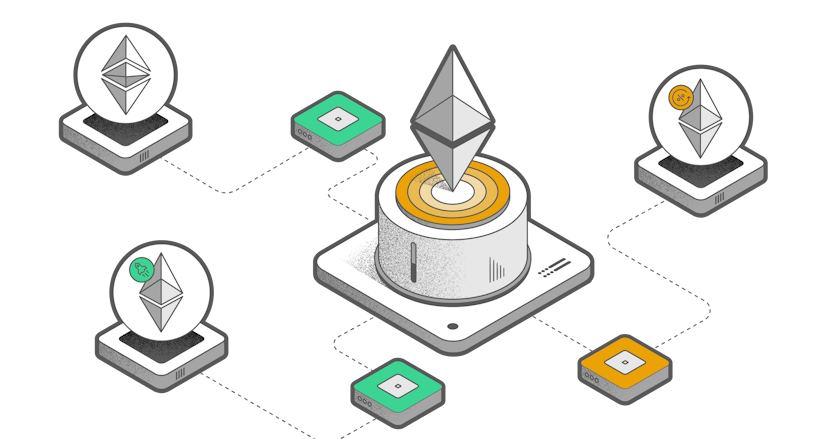
With its inception in 2015, Ethereum quickly emerged as more than just a cryptocurrency; it became the bedrock upon which a myriad of decentralized innovations were built. However, as its popularity surged, Ethereum’s limitations became increasingly evident. Scalability issues led to congestion and high transaction fees, hindering its potential as a mainstream platform. Furthermore, the energy-intensive Proof of Work (PoW) consensus mechanism drew criticism for its environmental impact. Enter Ethereum 2.0, a multi-phase upgrade set to revolutionize the Ethereum network. This article navigates the intricacies of Ethereum 2.0’s development roadmap and explores the far-reaching implications of this upgrade on the wider crypto landscape. From technical enhancements to ecological considerations, we delve into the aspects that make Ethereum 2.0 a beacon of promise for a more efficient and inclusive blockchain future.
Roadmap and Phases of Ethereum 2.0: Navigating the Evolution
Ethereum 2.0 represents a monumental leap forward in the evolution of blockchain technology. This ambitious upgrade unfolds through a carefully orchestrated series of phases, each designed to address the network’s limitations and unlock its full potential. Let’s embark on a journey through these phases, understanding their significance and the implications they hold for the crypto ecosystem.
- Phased Approach and Its Significance:
The transition to Ethereum 2.0 is no small feat, and its phased approach reflects a meticulous strategy for a seamless upgrade. By breaking down the implementation into multiple stages, Ethereum’s developers aim to manage complexity and ensure a smooth transition from the current version to the new paradigm. Each phase builds upon the previous one, incorporating novel solutions and improvements that collectively elevate Ethereum’s capabilities.

- Phase 0: Unveiling the Beacon Chain:
Phase 0 marked a pivotal moment in Ethereum’s journey. The introduction of the Beacon Chain, the PoS blockchain that orchestrates network consensus, laid the foundation for the subsequent phases. This event ushered in the era of PoS, a more energy-efficient consensus mechanism that enhances security and scalability.
- Phase 1: Scaling with Shard Chains:
Shard chains take center stage in Phase 1, presenting a game-changing solution for Ethereum’s scalability woes. These parallel chains enable the network to process multiple transactions and smart contracts simultaneously, significantly boosting throughput. As a result, Ethereum becomes better equipped to handle the demands of mainstream adoption and complex decentralized applications.
- Phase 1.5: Bridging the Gap:
Phase 1.5 serves as a crucial bridge between the Ethereum we know today and the future of Ethereum 2.0. During this phase, the Ethereum 1.0 chain will transition to become a shard on the Ethereum 2.0 network. This gradual shift ensures continuity while the benefits of Ethereum 2.0 start to take effect.
- Phase 2: Unleashing Full Potential:
Phase 2 represents the culmination of Ethereum 2.0’s transformation. This phase introduces state execution engines, enabling smart contracts to execute more efficiently, and cross-shard communication enhancements that facilitate seamless interaction between shards. These innovations bolster security, efficiency, and the overall user experience, solidifying Ethereum’s place as a dominant force in the crypto landscape.
- Navigating Challenges and Delays:
While the Ethereum community is eager to embrace the future, challenges and potential delays are inherent in any ambitious technological overhaul. Technical complexities, economic considerations, and unforeseen obstacles could impact the timeline of Ethereum 2.0’s rollout. Navigating these challenges requires a combination of careful planning, collaboration, and adaptability to ensure the upgrade’s success.
Implications for the Crypto Ecosystem: Shaping the Future with Ethereum 2.0
The advent of Ethereum 2.0 carries profound implications that ripple throughout the entire crypto ecosystem. As this upgrade unfolds, its effects resonate across various aspects of blockchain technology, revolutionizing scalability, sustainability, security, and investor sentiment.
- Scalability and Performance Boost:
Ethereum 2.0’s impact on scalability and performance cannot be understated. The transition from PoW to PoS and the implementation of shard chains result in faster transaction speeds and lower fees. This vital shift addresses long-standing challenges, making microtransactions viable and enhancing user experiences. Moreover, decentralized applications (DApps) and DeFi platforms stand to benefit significantly. The improved throughput enables smoother interactions and opens the door for complex applications that demand high transaction volumes.

- Energy Efficiency and Green Credentials:
Comparing the energy consumption of PoW and PoS reveals the profound environmental implications of Ethereum 2.0. The energy-efficient PoS mechanism drastically reduces carbon footprints, aligning with global sustainability goals. Ethereum’s pivot to a greener model not only lessens its impact on the environment but also showcases the industry’s commitment to responsible technology development.
- Decentralization and Enhanced Security:
The shift to PoS brings decentralization to the forefront. Ethereum 2.0’s PoS mechanism encourages wider participation by allowing users to stake their tokens and participate in consensus. This democratized approach enhances security, as a distributed network of validators guards against malicious activities. Furthermore, the reduced reliance on mining rigs diminishes the risks associated with centralization, fostering a healthier and more robust ecosystem.
- Competition and Blockchain Landscape:
Ethereum 2.0’s advancements also reverberate through the competitive landscape. In contrast to other smart contract platforms, Ethereum’s established brand and community give it a unique edge. However, this upgrade prompts competitors to innovate and adapt, catalyzing a dynamic and evolving blockchain ecosystem where excellence is the driving force.
- Investor and Developer Dynamics:
Investor sentiment in the crypto space is intricately tied to technological advancements. Ethereum 2.0’s realization enhances its appeal as a long-term investment, thanks to improved scalability and efficiency. Simultaneously, developers are drawn to Ethereum’s revitalized ecosystem. The promise of enhanced functionality, coupled with the allure of a greener and more secure platform, makes Ethereum 2.0 an attractive canvas for innovative projects.

